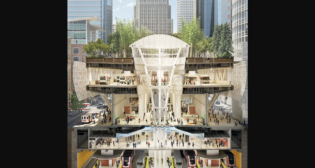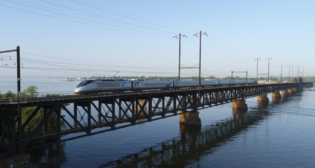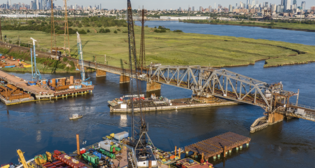
Safety: A collaborative process
Written by William C. Vantuono, Editor-in-ChiefThe FRA and the AAR’s Safety Appliance Task Force have joined forces to improve these safety-critical pieces of hardware. The FRA recently amended regulations related to safety appliance arrangements on railroad equipment.
The new rulemaking (effective June 27, 2011), FRA said, “will promote the safe placement and securement of safety appliances on modern rail equipment by establishing a process for the review and approval of existing industry standards.
This process will permit railroad industry representatives to submit requests for the approval of existing industry standards relating to the safety appliance arrangements on newly constructed railroad cars, locomotives, or other rail vehicles in lieu of the specific provisions currently contained in 49 CFR Part 231. It is anticipated that this special approval process will improve railroad safety by allowing FRA to consider technological advancements and ergonomic design standards for new car construction.”
The rulemaking, issued in April, is largely the result of a collaborative process between FRA and the AAR Safety Appliance Task Force. The Task Force, which consists of representatives from Class I’s, labor unions, carbuilders, and government (FRA and Transport Canada are non-voting members), as well as ergonomics experts, was created by AAR’s Equipment Engineering Committee “to develop new industry standards for safety appliance arrangements that could be used to reduce the differences of opinion that can arise in the interpretation of the Federal safety appliance standards contained in Part 231,” FRA said. “The Task Force has drafted a base safety appliance standard as well as industry safety appliance standards for modern boxcars, covered hopper cars, and bulkhead flat cars. These industry standards have been adopted by AAR’s Equipment Engineering Committee, and FRA expects them to serve as the core safety appliance criteria that can be used to guide safety appliance arrangements on railcars that are more specialized in design.”
The Task Force industry standards “incorporate ergonomic design principles that increase safety and comfort for persons working on and around safety appliance apparatuses,” FRA said. “For example, the standards establish minimum foot clearance guidelines for end platforms that allow for wider and stiffer sill steps to support a person’s weight.” The work is ongoing, and the AAR is currently working on an implementation plan for the new rules.
Said FRA: “The AAR petition to amend Part 231 requested that FRA adopt these new industry standards and amend its regulations to recognize changes in railcar design since the safety appliance regulations were promulgated in their current form. Because the standards submitted by AAR in connection with its petition require some modification before they can be approved and adopted by FRA, FRA is not incorporating the standards into Part 231 at this time. FRA prefers to utilize the process being established in this final rule to fully evaluate and assess the Task Force standards to ensure that they are complete and enforceable.”
(The railroad/regulator relationship wasn’t always so collaborative. See below.)
AAR initially submitted a petition to amend Part 231 on March 28, 2006. The petition requested a special approval process “that would enable the industry to submit new rail equipment designs to FRA for approval with respect to the placement and securement of safety appliances.” FRA said that it “anticipates that the special approval process will have multiple benefits, including allowing for greater flexibility within the railroad industry and increasing rail safety by incorporating modern ergonomic design standards and technological advancements in construction. . . . FRA recognizes the railroad industry has evolved over time.
“The industry has created and continues to create new railcar types to satisfy the demands for transporting freight as well as passengers on the present-day railroad [system]. Many of the modern railcar types that are presently being built to handle railroad traffic do not fit neatly within any of the specific car body types identified in the existing regulations and ambiguities sometimes arise regarding the placement of safety appliances on these car types. Because modern designs often cannot be considered a railcar type that is explicitly listed in Part 231, they are typically treated as cars of special construction.
“The ‘cars of special construction’ provision does not identify specific guidelines that can be used by the industry to assist it in the construction and maintenance of the safety appliances on modern railcar designs. Instead, it directs the industry to use the requirements, as nearly as possible, of the nearest approximate car type. Problems arise because modern designs are often combinations of multiple car types, and the design of any particular car may appear to be one type or another depending on the position of the individual viewing the car. As an example, a bulkhead flat car appears to be a box car when viewed from the A end or B-end of the car, but appears to be a flat car when viewed from either side. As a result, the industry is forced to use bits and pieces from multiple sections of Part 231 in an effort to ensure compliance with the Federal railroad safety appliance standards on bulkhead flatcars and other modern rail equipment.”
Another problem for modern railcar designs is that Part 231 defines the location of many safety appliances by reference to a railcar side or end. “While this worked well for the car types that were in existence [in 1911, when the ICC instituted the first safety appliance law], it often is difficult to define what parts on modern railcars constitute the side or end,” FRA said. “This creates ambiguity regarding what is the appropriate location for certain safety appliances, such as handholds and sill steps. Moreover, Part 231 requirements sometimes allow for spatial relationships between safety appliances that can result in their placement in less than optimal locations to ensure the safety of a person working in and around the railcar. For example, on tank cars without underframes, the center of the tread of the sill step can be up to 18 inches from the end of the car while the outside edge of the horizontal side handhold over the sill step can be up to 12 inches from the end. Consequently, a car built using these requirements may be compliant with the regulation even though the sill step and horizontal handhold are not aligned in a manner that maximizes safety.”
FRA said it responded to AAR’s petition for rulemaking “by establishing a special approval process similar to that which allows railroads to adopt an alternative standard for single car air brake tests and use new brake system technology where the alternative standard or new technology is shown to provide at least the equivalent level of safety. . . . Once an existing industry safety appliance standard or modification to an existing industry safety appliance standard is approved by FRA, it will become applicable to the industry for the purposes of new railcar construction.
As for passenger cars, APTA has accepted a request from FRA to develop an industry standard for the location, dimensions, material, and manner of attachment for safety appliances used on new passenger rail equipment. Railroads, suppliers, rail labor and safety regulators have been invited to participate. “A consensus process will be used,” APTA says. “This standard will be patterned after similar industry standards developed by the AAR for safety appliances used on new railroad freight cars.”
Our position 99 years ago
In June 1912, Railway Age Gazette reported on a controversy between the Master Car Builders Association and the Interstate Commerce Commission over “the influence of the safety appliance act on interchange.”
“As the law stands there is a penalty attached to the running of cars stenciled with ‘United States Safety Appliances,’ unless they are properly equipped,” we reported. “And, further, it is required that all cars passing through the shops for general repairs, whether of home or foreign roads, must be equipped with appliances. As [MCBA] President Stewart said, it is quite impossible to inspect all cars for standard safety appliances at interchange points, and therefore, a heavy provision should be incorporated in the rules of interchange for collecting any pieces, that may be imposed on the operating road, from the owner.
“Again, there should be a regular set of charges formulated for the application of the safety appliances. Both of these points should be comparatively easy adjustment, and should and probably will receive the prompt attention that they deserve.
“The Master Car Builders Association did very little regarding the matter of safety appliances. Doubtless it will be possible to make the same statement next week in reference to the Master Mechanics’ Association. There are two main reasons for this.
“One is that the safety appliance specifications adopted by the ICC are still new, and as in the main they are satisfactory under present conditions, there was not much opportunity for suggestions or discussions of proposed changes. The second reason is that legislation and the commission having taken the determination of what appliances shall be used out of the hands of the railways, there is a natural, and probably inevitable, disposition on the part of railway men to give comparatively little consideration to that matter.
“There is danger in this situation of affairs to which attention should be given during the present period of transition. It must be perfectly evident to every intelligent and thinking person that the Interstate Commerce Commission and its inspectors do not know, and never can know, the needs of the railways in respect to safety appliances and the best methods for meeting these needs, as well as the operating and mechanical officers of the railways know them. Even if the commission should employ as its advisers some of the most experiences and expert mechanical men in the country, who were not in railway services, they would be less able to decide what changes in appliances should be adopted from time to time than would the operating and mechanical officers of the railways; and the commission has no such expert advisers now. It is unfortunate that the commission and its inspectors sometimes seem inclined to proceed on the theory that it is their function to catch the railways in breaking laws and to prosecute them for it, rather than to co-operate with them in preventing accidents and removing their causes. This tends to excite antagonism and fear on the part of railway men, and to prevent them from engaging in that free discussion among themselves and from offering freely that advice to the commission which is so essential both to the most salutory administration of existing laws and regulations, and to the future progress in the development of the devices and methods that are necessary to best promote the safety of transportation.
“However, the present safety appliance specifications were adopted and the present boiler inspection law was framed after full consultation between the commission, the representatives of the railways and the representatives of the railway brotherhoods; and it is to be hoped that the same policy will obtain in future.
“The success of government regulation will be much greater and more certain, and economy and safety in transportation will be best furthered, if the commission will on all occasions frankly indicate to railway officers that it fully recognizes its need, and sincerely desires the benefit of their great collective experience and knowledge, and if railway officers will freely place their experience and wisdom at the commission’s disposal.
“The policy that will, in the long run, get the best results, is for the commission merely to give the force of law to the best judgment of railway men. If it tries to do anymore than this, it will do a great deal less. Public regulation should seek to prescribe ends, not means; regulating authorities are competent to say what ought to be accomplished, but they are, and always will be, far less competent than practical men in actual service, to say how it ought to be accomplished, and when they try to usurp the functions of the railway manager, the railways will be neither well regulated nor well managed.”



